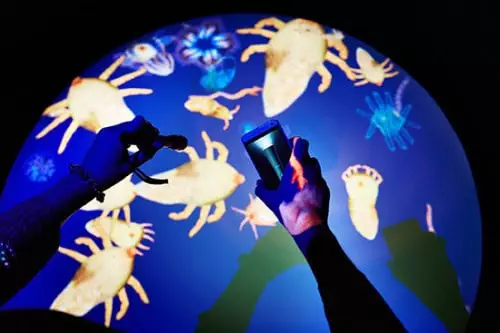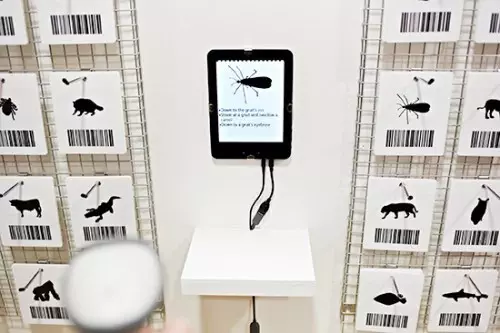
With the February half term just around the corner, Anders Anglesey previews the free-to-view Digital Zoo art installations at Trinity Leeds …
We do not live in the same world as our grandparents. Today we can glide seamlessly between the physical and digital realms. It is not unthinkable – in fact it is almost expected – that as you sit idly during your commute to work, with a pinch, a drag or a scroll you can be with anyone, anywhere on this planet.
It is this intersection of worlds that Digital Zoo wants you to explore through its installations dotted around Trinity Leeds. Whether you are a solitary passer-by or a family with children, there is something present to tease these thoughts loose.

Given that hundreds of children pass through Trinity Leeds everyday, it is very welcoming to see that some of the work has been designed specifically to engage and stretch their creative minds.
The Animalcules installation by Genetic Moo is a particular highlight. Enter the small booth on the first floor and you may be forgiven for wondering what is so special about this piece of technological art as you stand in the dark, hovering above a circle made up of ice-blue pixels with a flashlight in hand.

But shine the light onto any part of the circle and creatures will rise from the depths, following the light. It is not hard to imagine the curiosity and interest that will grip a child as they move the light around the circle and notice the blend of human and bacterial features each ‘animal’ has.
The theme of interaction runs through to artist Andy Deck’s piece Crow_Sourcing, which gives the participant the chance to scan a number of animals, via their respective barcodes, to see idioms associated with any of the available animals, displayed on a tablet.
Move behind the installation and you will be able to leave a drawing of an animal or a message on a blank space, which is a great opportunity for children to explore their creativity and reinforce the idioms they may have discovered for the first time.

In addition to the more child-oriented installations three pieces offer a more thought provoking and grown-up look at the consequences of the increasing degree to which technology is colonizing our everyday lives.
Kay’s Blog by Liz Sterry takes an unflinching look at the potential effects this combination can have on our lives, placing a particular emphasis on the lack of privacy that exists on the net. Over a period of three months, Liz followed Kay’s Blog, taking notes and printing images until she was able to recreate the teenager’s bedroom in full.
Once you have taken in the artist’s dedication to the subject matter and the incredible accuracy of the bedroom into account (you can compare the recreation to the photographs on display outside the room) you are left with an uncomfortable chill running down your spine. The very idea that a portal as narrow as a blog can allow a stranger to trace your life and movements to such a detailed extent is incredibly powerful, and increasingly relevant today.
Another installation that explores our loss of privacy, albeit in a more humorous way, is the work by Thompson & Craighead, which takes its inspiration from the London Wall. Plastered in red and black type on a small section of wall, are a number of tweets, collected within a one-mile radius of the shopping centre which gives even the most casual observer an insight into the thought process of a person they have never met. Or, perhaps, they are not the words of a stranger, but are yours instead.
Digital Zoo’s final offering, [borders] by Mary Flanagan, shows a series of ‘walks’ through a medium similar to Second Life. Straddling the boundary lines of the online landscape causes the programme to glitch and jerk; making the limitations to our online freedom more obvious the longer you stay with it.
“You can see that there is a message behind it (Digital Zoo).” Producer Alessandra Scapin told The Culture Vulture. “That can hopefully make you see things in a different way and make you realise how much technology is affecting our lives, and how we are acting without even realising it.”
Given the quality of the installations available and their casual drop-in, drop-out nature, it would more than worth the small amount of time it takes to view the artist’s work.
Digital Zoo will open to the public between 14-23 February – Trinity Leeds, Leeds, LS1 5AT.